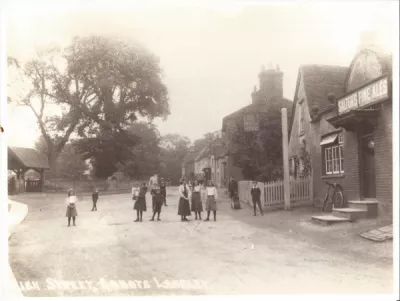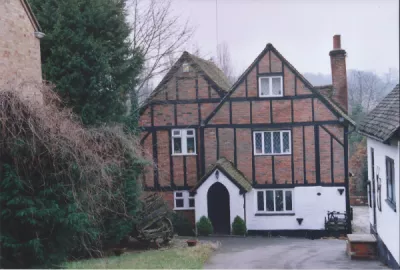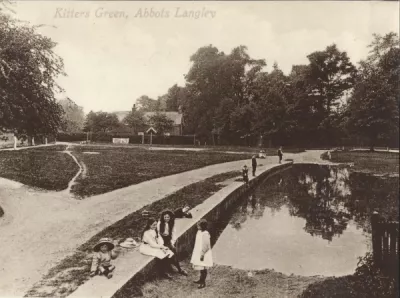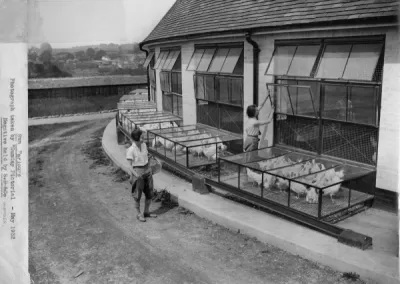Abbots Langley

ABBOTS LANGLEY
The Early Days
The text below is based on the work of Delva O'Regan and Lesley Brooks for ALLHS in August 2017.
Abbots Langley Parish is situated on the edge of the fertile Gade Valley and is made up of several settlements, including Abbots Langley, Bedmond, Kitters Green, Hunton Bridge, Langleybury and Leavesden. The village itself sits on a saucer of gravel covering various layers of clay over a base of chalk and early records show that water could be drawn from wells of only 20ft depth despite being some 220 feet above the valley bottom.
The 1873 Ordnance Map shows no fewer than 29 ponds in the parish, one of which, now lost, stretched the length of one side of what is now the village high street. The area was ideal for habitation by early man, and the archaeologist Sir John Evans (1823-1908) found evidence of this in his discovery of flint flakes, scrapers and other crude tools close to the surface in the local fields. A number of these are now housed in the Ashmolean Museum in Oxford. Celtic urns dating from period between 10BC-AD30, show evidence of habitation by local tribes during that period and tessellated paving and coins dating to the period between AD41-AD378, found in the 1980s during the laying of foundations for houses near the station, attest to Roman habitation.
Abbots Langley has a strong Local History Society, whose website is here.
Pope Adrian IV, c1100 – 1159.
Nicholas Breakspear was born in, or about, the year 1100, in Bedmond
in the Parish of Abbots Langley. It is believed that his father was
associated with the Abbey of St Albans, probably as a monk or a priest.
When Nicholas was about 18 years old, he too applied to enter St Albans
Abbey. However he was refused admission on the grounds that he had too
little schooling to qualify for entrance.
Undeterred by this refusal, Nicholas went abroad to study, briefly staying at St Denys in Paris then, via other places, to Avignon, where he became a monk in the Augustinian Abbey of St Rufus. He was elected Abbot in 1137 and earned a reputation as a stern leader with high standards. He was called to Rome, where Pope Eugenius III recognised his qualities and, having made him Cardinal of Albano, sent him on a mission to Scandinavia to restore peace and order to the local churches and monasteries and set up two new archbishoprics. After four years Nicholas returned to Rome, where the Pope was now the 90 year old Anastasius IV. Within a year the old Pope had died and in 1154 Nicholas found himself unanimously elected Pope. He took the name Adrian IV.
Adrian died 5 years later at Anagni on 1st September 1159.
A Chronology of Abbots Langley
1045 – 1154
1054 Ethelwine the Black and Wynfleda give a `Langelai' to the Abbot and monks of St Albans.
1066 Value of land to the lord is £15 (£12 in 1070)
1086 Paul de Cain is Abbot of St Albans and Lord of the Manor. Domesday book has the value of the land at £10.
1100 Nicholas Breakspear is born in Bedmond (see above).
1154 The parish church of St Lawrence the Martyr is dedicated. Originally of Norman structure, it has been restored and added to in the intervening years, including major works after a devastating fire on St Valentine's Day 1969.
In the same year as the dedication Nicholas Breakspear is elected Pope Adrian IV. That both the dedication of St. Lawrence church and the election of the pope both happened in the same year appears to be co- incidental.
1274 – 1535
1274 A royal palace is built at Kings Langley (Langelai Regis) by Edward I
1349 The Black Death arrives in Abbots Langley and seventy one people die in the Manor
1366 The Lord Abbot of St Albans gives a strip of land near the River Gade to Edward III
1396 John de la Mote, Abbot of St Albans, builds a Grange in Abbots Langley. This would have been used by his officials who would have held court and settled local disputes. The location of the building is not certain but may have been on the site of what was to become the Abbots House (see below).
1400 Richard II murdered at Pontefract Castle in Yorkshire. His body is brought to Kings Langley for burial. Later removed to Westminster Abbey by Henry V for reburial.
Early 1500s Cottages built opposite St Lawrence the Martyr church.
1536 – 1545
1539 The dissolution of the monasteries by Henry VIII brought the vast lands owned by the Abbey of St Albans under the Crown. Henry subsequently sold the Manor of Abbots Langley, along with the mill at Hunton Bridge, to one of his most distinguished commanders, the military engineer Sir Richard Lee, who subsequently sold the Manor back to the Crown.
1541 The Manor of Chambersbury (Rectory Manor) was sold by Henry VIII to his embroiderer William Ibgrave.
1545 The Manor and Estate of Langleybury was granted by Henry VIII to Sir Richard Lee. He sold it back to the Crown in 1575, and it remained a crown property until 1616.
1600 - 1641
c1600 Two storey building erected opposite the Church of St Lawrence, to become the basis of the Grade II listed building, The Abbots House. Surviving early 17th century barn, stables and oasthouse are still to be seen. The original buildings may have been the site of the Rectory Manor, a large hall where the Abbot's officials would have held their court and other large gatherings.
The Manor House is built, possibly on the site of an earlier moated house. One of the first, if not the first, residents of the house was Francis Combe, a wealthy miller from Hemel Hempstead, and his wife Ann Greenhill.
1616 Prince Charles (later King Charles I) owns the Manor of Langleybury and passes it to the Childe Family, who remained in occupation until 1711.
1631 Elizabeth White marries William Greenhill. During the next 37 years they are reputed to have had 39 children, with only one set of twins. The last son, Thomas Greenhill, was a noted surgeon to Henry Howard, 7th Duke of Norfolk. William became secretary to George Monck, 1st Duke of Albermarle, who was a key figure in the restoration of Charles II to the English throne.
1641 Death of Francis Combe (or Combes). He and his wife Anne (a daughter of Elizabeth and William Greenhill) were residents of the Manor House. Francis died without issue, and in his will left his properties in Abbots Langley to the Colleges of Sidney Sussex at Cambridge, and Trinity at Oxford, where he had been educated - Trinity College had been founded by his maternal great-uncle Sir Thomas Pope. He also bequeathed an acre of land immediately adjacent to St Lawrence church, and an income, for the benefit of the education and support of the poor of Abbots Langley. Trinity College had been founded by his maternal great-uncle Sir Thomas Pope.

1700 - 1800
This century was notable for a great number of large properties being built throughout the Parish, some of which have sadly now disappeared.
1720 Serge Hill House, Bedmond: Originally a Queen Anne style house, remodelled in 1811 by Busby, architect of Brighton and Hove for the Prince Regent.
Causeway House: A substantial house that took its name from an existing causeway running along the site. It was demolished in 1957.
1724 Langleybury House: the Georgian style house was occupied by Sir Robert Raymond, close friend of Sir Robert Walpole, England's first prime minister. He was appointed Lord Chief Justice of England in 1725 and ultimately elevated to be 1st Baron Raymond of Abbots Langley in 1731. There is a large, elaborate marble sculpture of Sir Robert Raymond as you enter the parish church.
1750's Langley House: Built by Sir John Cope Freeman. He had the main road through the village diverted around a large pond in front of his new house that kept villagers away from the house, but created a rather sharp bend that traffic still has to contend with today.
1760's Cecil Lodge: Built early in the decade, it was presented to Lord Cranbourne (later the Earl of Salisbury) upon his marriage. The house was badly damaged by fire in the 1930's and was demolished in 1953.
1763 Hunton Bridge: Luke Lewin, an Abbots Langley bricklayer, was engaged by the Sparrows Herne Turnpike Trust to erect a bridge to carry the road across the River Gade at Hunton Bridge. This was to replace an earlier bridge (which may have been of wooden construction or even a ford or watersplash). Unfortunately the camber of the bridge was rather steep and following a fatal accident, in which a carriage overturned negotiating a sharp bend, it was re-built in 1808 by the turnpike trustees.
c1776 A Poor House existed in the village at this time, believed to be in the area opposite St Lawrence Church. In 1776 it housed forty, mainly elderly or infirm, people. By 1790 this had increased to ninety inmates. It was closed in 1838 as a result of the New Poor Law of 1836, and the poor of the area were housed in a new Union workhouse at Watford. The house is now a private residence.
1797 The Grand Junction Canal, which was to become the Grand Union Canal in 1929, reached Hunton Bridge, having been started in Brentford in 1793. Although it probably had little effect on the majority of the agrarian population, it allowed a wharf to be built at Hunton Bridge and encouraged John Dickinson to build his Home Park paper mill on the edge of the parish in 1825.
1800 – 1900
1801 The population of the parish is recorded as 1,205 in the first national census. 30% of the population were 'employed in agriculture' (a figure which excluded the women and children who had vital but casual work in the fields), with just 8% 'in trade': 224 families lived in 222 houses and the sex ratio almost exactly 100:100.
1809 John Dickinson buys the paper mill at Apsley, on a site that had been recorded as a flour mill in the Domesday survey but which had been making paper for around fifty years.
1811 Dickinson expands his paper making business by purchasing Nash Mills, about a mile from Apsley. He and his wife Ann move into the Mill House, fronting onto the mill head.
1812 Hazelwood: Built by wealthy Londoner, Henry Botham and his wife Lydia. Henry originally bought 42 acres but eventually established an estate of 72 acres by purchasing further land from the Earl of Essex. The original house was destroyed by fire in 1908 and completely rebuilt. The building was renamed Hunton Park sometime around 1970, and is now a hotel. Among its notable residents was the Emperor Haile Selassie of Ethiopia, who lived there secretly during his exile in 1932.
1820 Rosehill: This house stood on Gallows Hill. One of its earliest residents was the Rev. Robert Coningham who fostered James Fitzjames, who joined the Navy at the age of 12 and later, as Captain of HMS Erebus, was the co-leader of the Franklin Expedition in 1847. The house was demolished in 1956.
Trowley House was sited where Follet Drive is today. It was particularly well known for its pear orchards and for having the only swimming pool in Abbots Langley. The house was demolished in 1958.
1826 John Dickinson begins production of specialised card for Jacquard weaving at Home Park Mill.
1836 Abbots Hill: A grand house built by John Dickinson. He lived here, with his wife and family, until his death in 1869. Since the early 1900's it has been a private girls’ school.
1837 Engineered by Robert Stevenson, the London to Boxmoor section of the London and Birmingham Railway (L&BR) was opened.
1839 A `second class station' is opened, due in part to the influence of John Dickinson. It is given the name Home Park Halt (today Kings Langley Station).
1844 Local tradesmen and farm workers are playing cricket under the banner of Abbots Langley Cricket club, using any suitable local field to play ad hoc games. By 1855 the club was well established and organised, with matches being played on a formal basis. In 1976, fire destroyed the club's permanent pavilion on the Manor House grounds and more than one hundred years of memorabilia was destroyed. With the support of the local Parish Council, in 1990 a new pavilion was built alongside the Manor House Sports and Social Centre.
1845 Booksellers Provident Retreat: John Dickinson gave three and a half acres of land to the Booksellers Provident Society for the erection of accommodation for their members and their widows, who were receiving an annuity. The building was built to face the railway line, perhaps to showcase it to the passengers coming out of London. The first of 24 modern bungalows was added in 1965 and was followed by further flats and communal areas.
1853 The boys' school on the land bequeathed two hundred years before by Francis Coombe was re-built, now as a Church School, that could support up to ninety pupils a week. Readers will note that this was the same year as the foundation of the school at Chorleywood.
1856 Model Cottages: At the Great Exhibition of 1851 Prince Albert asked the architect Henry Roberts to design homes for improving the conditions of the labouring classes. In 1856 a group of these houses were erected in Tibbs Hill Road, where they still stand.
1864 St Paul's Church, Langleybury, was built by William Jones Loyd, who lived in Langleybury House. The architect was Henry Woodyer, who designed the church in the early English decorated Gothic Style.
1866 The old Causeway House and lands were sold following the death of Sarah Smith. This led to the lands being split up into small parcels of land and sold to local builders, who each built three or four houses, sold them and used the money to buy another parcel of land, and build three or four more houses. So the residential area of Breakspeare Road, Adrian Road, Garden Road, and Marlin Square came about, and filled in the gap between the village centre and Kitters Green. It must have led to a steep increase in people living in the village.
c1866 Abbots Langley Gardening Society established.
1868 A Girls School was built, close by the Boys School, supported by Susannah Freeman's bequest. Today the site of the village library.
1868 The St. Pancras guardians of the Poor build the St. Pancras Orphanage and Industrial School for Pauper Children at Leavesden. It was common for the central London parishes to make this sort of provision well away from their own area.
1870 Leavesden hospital established by Metropolitan Asylum board. It now has a strong History Association recording and preserving the legacy of a great deal of important work done there.
1880 The Church of the Ascension in Bedmond is erected. It is part of the Parish of St Lawrence in Abbots Langley and is known locally as the ‘Tin Church’ because of its corrugated-iron shell. Seating around 60 people, it has a simple wooden interior with chairs which were replaced in the late 1980s.
1881 At the instigation of Matthew Timberlake, a noted figure in the local Methodist community, the New Wesleyan Chapel was built. Prior to this Methodist meetings were held on the village green and then in various members' houses.
1894 Abbots Langley Parish Council is established.
1900 – 1999
1909 Abbots Langley Scouts founded
1913 A. Wander Ltd build a factory to manufacture Ovaltine in the Gade valley, on a site on the boundary of Kings Langley and Abbots Langley.
1914-18 Around 700 men and women from Abbots Langley and Bedmond served in the Great War. This number becomes over 1000 if those from Hunton Bridge, Leavesden and Kings Langley are included.
1924 Between 1924 and 1930 A. Wander Ltd. purchased Parsonage Farm and Numbers Farms in Abbots Langley on which they established the Ovaltine Dairy, a model farm, and a poultry farm respectively. They form a small fleet of canal boats to carry coal for the factory from the Warwickshire coal fields: these boats were renowned for their fine decoration and smart appearance.


Ovaltine - the sun parlours
Ovaltine came to Abbots Langley when A. Wander, having set up the British arm of the Swiss firm in 1909, established a new factory, and farms to provide for it, on the boundary of Abbots Langley and Kings Langley in 1913. This is the poultry farm, providing eggs.
2000 -
2000 The first Harry Potter film The Philosopher's Stone, is made at Leavesden studios, followed by all of the others in the series. In 2010 Warner Brothers purchases Leavesden studios rebranding it Warner Brothers Studios, Leavesden.
2014 Establishment of Back to the Front: Great War Commemoration Project. A community-based project to research, record and remember the hundreds of men and women of Abbots Langley, Bedmond, Hunton Bridge and Leavesden who served in the Great War.
1924 Abbots Langley Guides founded.
1935 Abbots Langley Bowling Club established at the location still used today.
1940 The Air Ministry requisitions land at Leavesden for an aircraft factory for the production of Halifax bombers and Mosquito fighter/bombers that played a vital part in WW2. After the war De Havilland used the factory to continue the manufacture and maintenance of aero engines. Following a number of take-overs and amalgamations the site eventually devolved to Rolls-Royce, who built helicopter engines there until 1992. From the 1950s to 1970s the field played host to a number of air taxi/charter companies and even scheduled services. Various flying schools were based there, and pleasure flights in airships were a popular attraction.
1949 Langleybury estate is sold to Hertfordshire County Council, who convert Langleybury house and grounds into a secondary school, which it continued to be until 1996.
1950 The Abbots Langley Gilbert & Sullivan Society is founded. It continues to perform G&S operas annually.
1960 Langleybury Children’s Farm is attached to Langleybury school as part of the 400 acre estate gifted to the Local County Council.
1964 St Saviour Roman Catholic Church consecrated.
1967 The Abbots Langley football club founded.
1974 Local government re-organisation – Three Rivers District Council created.
1982 The new modern Library is opened.
1986 M25 Gade Valley viaduct opened, as part of the last 8 mile section that completed the circle of the London Orbital Motorway.
1991 Biennial Abbots Langley Festival of the Arts established.
1994 Abbots Langley Local History Society established.
1996 The Leavesden Aerodrome site changes its use from aeronautics to to the film industry and becomes locally known as Leavesden studios. Many film companies used the site, with Star Wars Episode 1: the Phantom Menace being amongst the first.